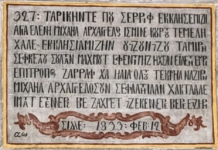Tophane is a very pleasant area to spend an afternoon smoking nargile and playing tavla. Or, if you are more into art than the dolce far niente, you can choose to just wander around Istanbul Modern. While in the neighborhood you may notice the distinctive turrets atop a building on the corner of the steep street coming down from Istiklal. These small towers with circular tops could trick you into thinking that you are in front of yet another hamam. But look closer. You will discover a gem of Istanbul, the magnificient Tophane-i Amire Culture & Arts Center.

This building was constructed in the fifteenth century during the reign of Sultan Mehmed II, the same sultan who sieged and conquered Constantinople in 1453.
Its first use was as a place to manufacture cannons and their ammunition for the Ottoman army and navy. As a matter of fact, this ancient harbourside suburb received the name of “Top hane”(“cannon foundry”) after this building and it became the area where the Ottoman military industry established its production.
This old cannon-ball casting factory was rebuilt shortly after the big Firuz Agha fire in 1823, which leveled the former structure. During the twentieth century this barracks served a number of purposes: as a training space, an education centre and a military museum. In 1992, Tophane-i Amire was transferred to the nearby Mimar Sinan University, a state university of fine arts. The university converted it into a multi-purpose space consisting of three exhibition halls: the Tophane-i Amire Beş Kubbe, the Tophane-i Amire Tek Kubbe and the Tophane-i Amire Sarnıçlar.

The main exhibition hall, Beş Kubbe (5 domes), is a 48 x 22 meters rectangle where two collonades divide the structure into three naves. The central aisle is wider and its topped by the aforementioned 5 domes supported by massive stone pillars. Pointed arcades support the bricked domes. The cupolas are perforated with circular clerestory openings that allow the entrance of natural light into the otherwise opaque space. The lateral aisles are crowned by the distinctive turrets and the upper part of the walls are pierced with hexagonal openings. This is a distinctive architectural feature also used in traditional Ottoman hamams.
This 1150 square meters space offers an interesting juxtaposition of contemporary exhibitons against the backdrop of a classic Ottoman building; it is a striking contrast of past and present. Since its opening this space has hosted important exhibitions such as Salvador Dali and Michelangelo’s Great Masters.
The next hall, Tek Kubbe (single dome), is a single space covered by a masonry dome. With its 250 square meters, this space has the contemporary addition of a glass floor. This implementation enables natural light to pass from this floor to the one below and provides a visual connection between the spaces. The contrast between the Ottoman dome and the new high-tech addition makes for a great exhibition space and a delightful surprise for the visitor. Adjacent to this space, the Tophane-i Amire Sarnıçlar, was formerly used as water deposits and currently serves as exhibition storage.

These three spaces have a peculiar articulation in the site. Tek Kubbe and Sarnıçlar are parallel to the main street while Beş Kubbe is slightly rotated to have a North-South orientation. This layout creates an interstice space that allows a stair to link the difference of levels of the steep site. This apparently random position of the volumes actually provides an efficient integration into the sloped location.
Finally, when you visit an exhibition there, stop on the front terrace for an amazing view of the Kılıç Ali Pasha Complex, designed by Mimar Sinan, across the street. With all these architectural wonders, Tophane should be high on your list of places to explore.
Boğazkesen Cad. Defterdar Yokuşu No: 2
Tophane, Beyoğlu
Opening hours from 10:00 am to 7:00 pm every day.
The Tophane stop on the Bağcılar-Kabataş tram line drops you off in front of the cultural centre.
Santiago Brusadin is a contributor to Yabangee. This article is part of a series on impressive buildings in Istanbul.
[geo_mashup_map]










